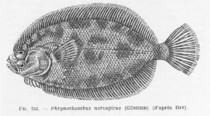Norwegian topknot
The Norwegian topknot lives in the benthopelagic, marine, usually 10 - 200 m environment.
Distribution: The Norwegian topknot is often seen on rocky substrate where brown and pink colors dominate. It prefers depths between 5 and 50 meters, but has been registered as deep as 200 meters. More
The Norwegian Topknot is found inshore on rough, stony ground. Food: Feeds on small invertebrates and fish eggs. More
The Norwegian topknot is a left-eyed flatfish that is oval in shape and more slender than other topknot species. It is also the smallest of the topknots, reaching a maximum length of 12cm. More
such as Norwegian topknot and gilthead bream is especially encouraging,’ said Rob Hillman for the Environment Agency. More
Norwegian topknot is regularly found in the shallows, down to about 18m. This is probably the most colourful zone of our inshore waters and rocks are often a warm, pinkish-purple colour, thanks to encrusting algae. More
Common names
Bruxa-norueguesa in Portuguese (Português)
dwergbot in Dutch (Nederlands)
Dwergtarbot in Dutch (Nederlands)
Limanda noruega in Spanish (español)
Litli flóki in Icelandic (Íslenska)
Norskakvoysa in Faroese (Føroyskt)
Norwegian topknot in English
Norwegian topknot in Ukrainian (українська мова)
Norwegischer Zwergbutt in German (Deutsch)
petit turbot de roche in French (français)
Pikkukampela in Finnish (suomen kieli)
Rombo peloso in Italian (Italiano)
Småhvarre in Danish (dansk)
Småvar in Norwegian (Norsk)
Småvar in Swedish (Svenska)
Targie naine in French (français)
Turbotek norweski in Polish (polski)
Zwergbutt in German (Deutsch)
ромб карликовый in Russian (русский язык)
挪威蟾鮃 in Mandarin Chinese
挪威蟾鲆 in Mandarin Chinese


Family : Scophthalmidae
Genus : Phrynorhombus
Species : Phrynorhombus norvegicus
Authority : G
